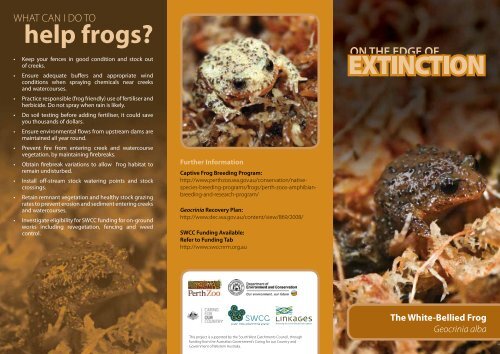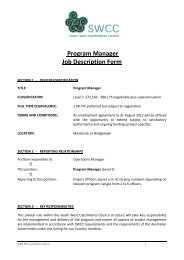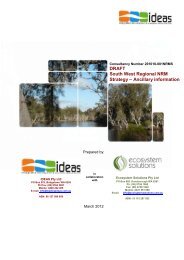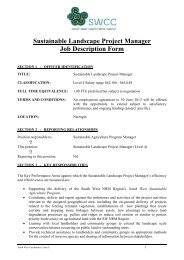On the edge of extinction Geocrinia brochure - South West ...
On the edge of extinction Geocrinia brochure - South West ...
On the edge of extinction Geocrinia brochure - South West ...
You also want an ePaper? Increase the reach of your titles
YUMPU automatically turns print PDFs into web optimized ePapers that Google loves.
WHAT CAN I DO TO<br />
help frogs?<br />
• Keep your fences in good condition and stock out<br />
<strong>of</strong> creeks.<br />
• Ensure adequate buffers and appropriate wind<br />
conditions when spraying chemicals near creeks<br />
and watercourses.<br />
• Practice responsible (frog friendly) use <strong>of</strong> fertiliser and<br />
herbicide. Do not spray when rain is likely.<br />
• Do soil testing before adding fertiliser, it could save<br />
you thousands <strong>of</strong> dollars.<br />
• Ensure environmental flows from upstream dams are<br />
maintained all year round.<br />
• Prevent fire from entering creek and watercourse<br />
vegetation, by maintaining firebreaks.<br />
• Obtain firebreak variations to allow frog habitat to<br />
remain undisturbed.<br />
• Install <strong>of</strong>f-stream stock watering points and stock<br />
crossings.<br />
• Retain remnant vegetation and healthy stock grazing<br />
rates to prevent erosion and sediment entering creeks<br />
and watercourses.<br />
• Investigate eligibility for SWCC funding for on-ground<br />
works including revegetation, fencing and weed<br />
control.<br />
Fur<strong>the</strong>r Information<br />
Captive Frog Breeding Program:<br />
http://www.perthzoo.wa.gov.au/conservation/nativespecies-breeding-programs/frogs/perth-zoos-amphibianbreeding-and-research-program/<br />
<strong>Geocrinia</strong> Recovery Plan:<br />
http://www.dec.wa.gov.au/content/view/869/2008/<br />
SWCC Funding Available:<br />
Refer to Funding Tab<br />
http://www.swccnrm.org.au<br />
This project is supported by <strong>the</strong> <strong>South</strong> <strong>West</strong> Catchments Council, through<br />
funding from <strong>the</strong> Australian Government’s Caring for our Country and<br />
Government <strong>of</strong> <strong>West</strong>ern Australia.<br />
The White-Bellied Frog<br />
<strong>Geocrinia</strong> alba
White-Bellied Frogs<br />
<strong>On</strong> <strong>the</strong> <strong>edge</strong> <strong>of</strong> <strong>extinction</strong><br />
White-Bellied Frogs (<strong>Geocrinia</strong> alba) are almost extinct.<br />
The number <strong>of</strong> sites where <strong>the</strong>se frogs can be found have<br />
declined by about 30% over <strong>the</strong> last 10 years . Many creek<br />
lines around Margaret River and Witchcliffe have fallen<br />
silent, or only have one or two males left calling for a mate.<br />
The Orange-Bellied Frog (<strong>Geocrinia</strong> vitellina) is also<br />
threatened, being restricted to an area <strong>of</strong> habitat so narrow<br />
that a single fire event could render this species extinct.<br />
This species occurs in state forest north <strong>of</strong> <strong>the</strong> Blackwood<br />
River, south east <strong>of</strong> Margaret River.<br />
Perth Zoo, in partnership with Department <strong>of</strong> Environment<br />
and Conservation and funding partner <strong>the</strong> <strong>South</strong> <strong>West</strong><br />
Catchments Council, has established a ground-breaking<br />
captive rearing and breed-for-release program for <strong>the</strong>se<br />
threatened frogs to help boost <strong>the</strong>ir numbers in <strong>the</strong> wild.<br />
Early results are encouraging with a number <strong>of</strong> male White-<br />
Bellied Frogs heard calling in 2011 following <strong>the</strong> first release<br />
<strong>of</strong> <strong>Geocrinia</strong> alba juveniles in 2010.<br />
What threatens <strong>Geocrinia</strong> frogs?<br />
1. Habitat destruction from clearing and habitat<br />
fragmentation (G.alba live in Margaret River area<br />
with only 1.9km 2 <strong>of</strong> suitable habitat remaining).<br />
2. Changed fire regimes. Fire has previously reduced<br />
populations by 60%.<br />
3. Trampling and disturbance by people and stock or<br />
feral pigs.<br />
4. Disease. Chytrid fungus spores have been detected<br />
from frogs at all sites tested so far.<br />
5. Poor water quality from fertiliser and or herbicide run <strong>of</strong>f.<br />
6. Altered hydrology and climate change.<br />
Illegal drug crops<br />
The growing <strong>of</strong> drug crops along creek lines in o<strong>the</strong>rwise<br />
pristine habitats is having a major impact on <strong>the</strong> remaining<br />
frog populations.<br />
The activity has multiple impacts on <strong>the</strong> frogs as <strong>the</strong> clearing<br />
<strong>of</strong> undergrowth makes <strong>the</strong> area hotter, herbicide spraying to<br />
prevent regrowth is toxic and <strong>the</strong> heavy application <strong>of</strong> fertiliser<br />
to improve crop growth contaminates <strong>the</strong> site and builds up in<br />
<strong>the</strong> soil over time.<br />
The phosphates from fertiliser and breakdown products from<br />
herbicides disrupt growth and development <strong>of</strong> frogs. At an<br />
illegal crop site found last year, all frogs had disappeared and<br />
all egg nests laid in <strong>the</strong> zone up to 100m downstream <strong>of</strong> <strong>the</strong><br />
crop failed to hatch.<br />
1st release <strong>of</strong> captive reared <strong>Geocrinia</strong> alba juveniles, 2010<br />
What are we doing to help frogs?<br />
• Department <strong>of</strong> Environment and Conservation<br />
manages <strong>the</strong> <strong>Geocrinia</strong> Recovery Plan, fire risk, protects<br />
habitat on crown land, monitors populations and<br />
manages translocations.<br />
• Perth Zoo<br />
manages captive breeding and rearing, provides animals<br />
for release and monitors disease issues.<br />
• <strong>South</strong> <strong>West</strong> Catchments Council (SWCC)<br />
manages community education, landholder capacity<br />
building and implements on-ground works (fencing,<br />
weed control, revegetation) to improve habitat<br />
condition.<br />
SWCC also provides additional funding to support <strong>the</strong><br />
captive breeding program.<br />
<strong>Geocrinia</strong> alba. Perth Zoo<br />
What do <strong>Geocrinia</strong> frogs need?<br />
• A cool moist place to live, along <strong>the</strong> <strong>edge</strong>s <strong>of</strong><br />
creeks with a year round water supply.<br />
• Lots <strong>of</strong> undergrowth, leaf litter and trees<br />
overhead for shade along <strong>the</strong> <strong>edge</strong>s <strong>of</strong> creeks<br />
(but not in <strong>the</strong> water).<br />
• Clean water and clean soil, free <strong>of</strong> herbicide<br />
and fertiliser.<br />
• A stable habitat free from fire, stock and<br />
machinery disturbance.<br />
Illegal drug crop<br />
1st release <strong>of</strong> captive reared <strong>Geocrinia</strong> alba juveniles, 2010






